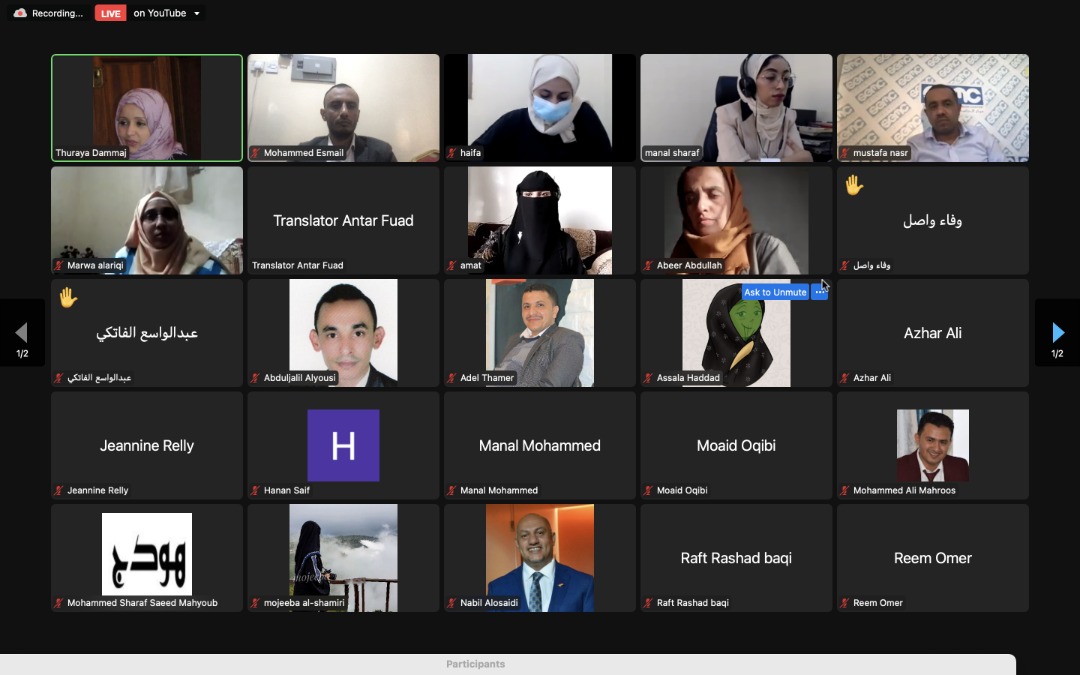(In the webinar for SEMC about the presence of Yemeni women journalists in decision-making positions in Yemeni media)
Many of Yemeni women journalists have presented their success stories in the webinar which SEMC has organized, and they have talked about their role in running the Yemeni media and the presence of Yemeni women journalists in decision-making positions in Yemeni media, also the obstacles and risks they have been facing.
In the opening of webinar, it has participated different selected journalists that part of #Makanati project which implemented by the French Agency of Media Development (CFI) with a partnership with SEMC and funded by the French Ministry of Foreign Affairs of Europe.
Mr. Mostafa Nasr (the chairman of SEMC) has pointed that Yemen certifies many pioneer's women journalists since the 1960s and contributed in Yemeni media industry, which it has put Yemeni women journalists in front of the responsible to continue playing the role in leading Yemeni media. Also, he has pointed that there are new examples for women journalists who have presenting brightly examples in Yemeni media and have got local, regional and international awards. On the other hand; one of these success stories, Launch of the Hodaj platform running by a successful women journalists team.Plus, Mr. Nasr added that in the biggest challenges faced by women journalist compared to men journalists; under the during circumstances, SEMC has developed a policy since its establishment to put the woman in every activity unless 30%, and we ensure that woman is the same fully engaged as the man.
However; Makanti project’s coordinator (Haifa Al Odaine) has presented detailed explanation about the project and its activities which implemented in 5 main governorates such as Sana’a, Aden, Taiz, Alhodaida and Hadhrmout, it has targeted 150 journalists and produced several press materials as 86 written, 22 video, 11 podcast and 2 multimedia materials.
Also, she added that during the project, it has signed memorandums with 14 media foundations and trained women journalists in the project’s activities, for example: journalism editing, advocacy, leadership skills, digital security and occupational safety.
The editor-in-chief of Hodaj platform (Marwa Al-Areqi) has presented a study carried out by the French Agency last year, 2021, women's status in Yemeni media was shown by a very small 20% the presence in media organizations, of whom 60% worked in visual and audio media and 40% in print journalism. In addition; the presence of female journalists is concentrated in the Yemeni news agency Seba and the 14 October newspaper, and in both the revolution newspapers and the Republic, which are government institutions. The number of female journalists working on websites is 5% lower than that of men.She also talked about constraints faced by women journalists, including those related to society, those related to media institutions and those related to legislative policies.
Otherwise, The Editor – in – Chief of Yemen future, Thuria Dmaj, reviewed her experience in journalism, despite the difficulties faced by women journalists from being marginalized at all levels of government and private media, with only marginal work.
Over the coming period, we were launching a vision that allowed many women journalists to work through many programs that sought to provide professional and free journalism.
Also, The Editor – in – Chief of Ta platform (Abeer Abdullah) spoke about her experience in her journalism work and the challenges they faced in the platform, which she described as security, financial and technical challenges.
Since its establishment, the platform had made room for all women journalists, and we had not set limits on our treatment or on those who wanted to contribute to us. That was what we saw as a long-term force factor, as a platform that had demonstrated its presence among other women’s platforms in Yemen.
Though, Hannah El Grady (Media Managing Director and the operator of Belqees Channel) also reported on the channel’s experience in involving women journalists in decision-making, stating that “there are no challenges and constraints in involving women journalists in decision-making as is the case in other institutions.
The channel had provided considerable scope for women journalists in all sections to manage, deliver and produce according to competence and experience, and therefore women journalists had served as program managers, broadcasters, equipment and other sections.
According to The deputy editor of Al – Hudaydah News, Amat-Al Razak Al-Qazahi, has spoken about her beginnings in the work until she reached the deputy editor of the site, after the Department had seen qualitative additions to journalism and the need for women to be present in decision-making, which had played a significant role in achieving further successes.
She has confirmed that Hudaydah News was the only news site that stood up to the war in the city of Alhodaida and continued to operate despite the difficult conditions of power outages, the Internet, access to information and the exodus of journalists.
As well as, Ghassan Salim Abdun (Hadhrmout Channel program and news director) was unable to participate in the webinar due to the poor service of the Internet, which was supposed to talk about Hadhrmout in involving Yemeni women journalists in “Yemeni examples” decision-making positions.
In brief, a number of interventions were made by women journalists and journalists. They stressed the importance of continuing to highlight issues relating to Yemeni women journalists. The journalist, Wafa Wasel, working on Sana'a Radio of the legitimate Government, spoke of the great marginalization of government media. In Sana'a Radio, there are only two women broadcasters, in the Yemen Channel only five journalists, and in the Yemeni News Agency are three journalists are not involved in decision-making. Also, she has talked about the suffering which has engaged all the journalists which she confirmed that women journalists have been facing bigger obstacles, however; another journalist has said that her family hasn't allow her to work in journalism field. 
COMMENTS